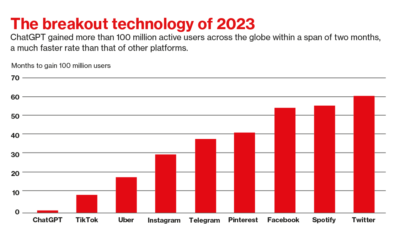Politics
Welcome to the E-Commerce Era of Home Services
Published
1 year agoon
By
Drew Simpson
The home services industry, a $700 billion market in the U.S. alone, encompasses a wide array of trades such as plumbing, lawn care, house cleaning, HVAC, and electrical work that serve as the backbone of modern life. All of the beloved apps and entertainment we use in our homes are irrelevant if the electricity goes out. Tradespeople and their businesses see ever-increasing demand because they make our homes safe, comfortable, and efficient by providing essential services that enhance our daily lives. Moreover, a successful career in these trades offers a stable and rewarding lifestyle, as evidenced by the growing pride and popularity among younger people.
And, according to the latest studies, we’ll need them.
We’re seeing a significant upswing in demand for these services, with a 10% increase since 2021 — and as a result, 77% of tradespeople now view labor shortages as a pressing issue. This has paved the way for income growth in the sector, with 83% of individuals in these trades expressing satisfaction or extreme satisfaction with their chosen line of work.
Due to labor shortages, trades businesses are turning to technology to boost efficiency and productivity, allowing them to accomplish more with fewer resources. At the same time, consumers increasingly expect tradespeople to offer their services through digital platforms.
This creates an urgent need for industry innovation, including user-friendly tools for website building, digital payments, quotes, and planning. In addition, homeowners increasingly expect to find, book, and pay for services online. But fewer than half of home services businesses even have a website – and for most of those that do, their website is usually just some pictures and a phone number to call. As a result, trades businesses in the market need to adapt swiftly to meet this consumer demand.
Let’s explore the factors contributing to the digital transformation of the home services industry and how this shift benefits both tradespeople and consumers alike.
Demand for online, on-demand home services
We can thank (yes, thank) the COVID-19 pandemic for shifting not just how we work but the way we live, especially when spending on on-demand services. For the last three years, consumers have forced the entire economy to prioritize meeting them where they are. At first, a health and safety matter, operating predominantly online has expanded businesses’ opportunities to save money and generate revenue simultaneously. And importantly, consumers enjoy – and have come to expect – that option.
We witnessed this with the U.S. home services industry when it grew by more than 3 percent in 2020, despite the country’s economy shrinking by 3.5 percent in the same year. And the trend continues. The home services industry saw a growth rate double that of the rest of the U.S. economy between 2021 and 2022.
As we look to the future, the industry shows no signs of slowing down. For instance, house cleaning services are expected to grow by 17% in the coming years. Lawn and landscaping, another critical sector, generates $176 billion annually in the U.S., employing over 1.3 million people across 650,000 businesses. This sector has enjoyed a consistent 8% growth rate annually over the past five years.
With much of the world returned to pre-pandemic activity, the evolution of the home services market will rely on expanding its reach by continuing tolean into its omnichannel presence. That involves reaching customers how they prefer, including booking appointments online, communicating via text message, and offering contactless payments.
Career outlook for home services professionals
So who are we talking about when we say “home services?” It’s any profession that helps make the quality of life at home better. These professions include plumbers, landscapers, cleaners, pest control experts, handypersons, electricians, painters, floorers, roofers, pavers, tilers, locksmiths, contractors – you know, the people who make things work.
People are increasingly choosing to go into these trades instead of pursuing traditional college degrees for many reasons, which I’ll spell out.
Cost-effectiveness
Starting your life with a mountain of debt is not an attractive outlook for many people. So if young adults can help it, they avoid it. In contrast, trade schools or apprenticeships typically cost less. As a result, they take less time to complete, making them a more affordable education and skill development option.
Demand and stability
There’s a constant demand for skilled tradespeople. These jobs are essential to maintaining and improving infrastructure, homes, and commercial properties. This demand often translates to increased job stability and opportunities for long-term careers. You’ll always need plumbers, contractors, and other professionals to literally keep your house in order. When any homeowner compares how much they spend on home services contractors each year – from roofing, to HVAC, to appliance repair, to lawn care – they usually find the total is much more than almost any other category in their annual budget. This bodes well for stability and demand in the trades.
Matter of preference and faster entry into the workforce
Many individuals want the hands-on learning approach provided by trade schools and apprenticeships, as opposed to traditional colleges’ more theoretical and lecture-based style. In addition, trade programs usually take considerably less time to complete than a traditional four-year college degree, allowing people to enter the workforce more quickly and start earning a living sooner.
Earning potential and entrepreneurship opportunities
Skilled tradespeople can often earn competitive salaries, especially as they gain experience and establish a reputation for quality work. In some cases, trades’ income potential can surpass jobs requiring a traditional college degree. These careers also offer a pathway to becoming self-employed or starting a small business, giving people more control over their work, income, and lifestyle. It isn’t uncommon to see a business owner in the trades making the sort of high income and lifestyle that would command respect – even outright awe – from someone with advanced college degrees.
Tools for home services entrepreneurs
Entrepreneurs need to embrace various tools and technologies to run a successful and efficient trade business. One essential element is a professional website featuring an integrated booking system, allowing clients to quickly schedule appointments and access important information about the company. Equally important is implementing customer relationship management (CRM) software, which helps manage and nurture customer relationships, leading to better retention and increased sales.
These businesses also need job management tools like software solutions that help assign tasks, monitor progress, and facilitate communication among team members to streamline the overall operation. And integrating invoicing and payment processing systems not only saves time but also ensures prompt payments from clients. AI has opened the door to virtual assistants and utilities that can answer the phones and book new jobs, take payments, and answer questions while the tradesperson is out on the work site. Lastly, digital marketing tools, including social media management and email marketing, effectively promote the business and attract new clients.
Key takeaway
The digital transformation of the home services industry promises significant economic growth, job creation, and technological innovation in a new e-commerce era. As businesses adopt innovative tools and strategies, they can improve efficiency and customer satisfaction and secure a competitive edge in this rapidly changing landscape.
This shift will redefine how tradespeople conduct business, opening up new opportunities for those seeking financial independence and a rewarding career beyond traditional office roles.
As a founder in this thriving industry, I am excited to witness our tradespeople and businesses’ remarkable progress and resilience. Together, we will continue to innovate and adapt, embracing the challenges and opportunities that lie ahead to forge a prosperous future for the home services industry.
Brig Graff is co-founder of Trady, a free, AI-powered website builder, CRM, job management and pricing tool for trades businesses and home services contractors.
Brig Graff
Brig Graff is Cofounder of Trady, a tech company that builds AI-powered software for trades businesses. Brig has also been an executive at multiple successful unicorn tech companies that have gone public, including Domo and Omniture. Previously, he was the global leader of Adobe’s Solution Architecture team, and was head of e-commerce at Overstock.
You may like
-


Finding value in generative AI for financial services
-


AI gains momentum in core manufacturing services functions
-


Accel leads Lottie’s series A round, elevating the UK’s care services with a £16.35M boost
-


Using Augmented Reality to Level up your E-Commerce Business
-


Nintendo to discontinue 3DS and Wii U services in 2024
-


A Pioneering Frontier and Brainchild of Technology- Hyperlocal E-commerce
Politics
Fintech Kennek raises $12.5M seed round to digitize lending
Published
7 months agoon
10/11/2023By
Drew Simpson
London-based fintech startup Kennek has raised $12.5 million in seed funding to expand its lending operating system.
According to an Oct. 10 tech.eu report, the round was led by HV Capital and included participation from Dutch Founders Fund, AlbionVC, FFVC, Plug & Play Ventures, and Syndicate One. Kennek offers software-as-a-service tools to help non-bank lenders streamline their operations using open banking, open finance, and payments.
The platform aims to automate time-consuming manual tasks and consolidate fragmented data to simplify lending. Xavier De Pauw, founder of Kennek said:
“Until kennek, lenders had to devote countless hours to menial operational tasks and deal with jumbled and hard-coded data – which makes every other part of lending a headache. As former lenders ourselves, we lived and breathed these frustrations, and built kennek to make them a thing of the past.”
The company said the latest funding round was oversubscribed and closed quickly despite the challenging fundraising environment. The new capital will be used to expand Kennek’s engineering team and strengthen its market position in the UK while exploring expansion into other European markets. Barbod Namini, Partner at lead investor HV Capital, commented on the investment:
“Kennek has developed an ambitious and genuinely unique proposition which we think can be the foundation of the entire alternative lending space. […] It is a complicated market and a solution that brings together all information and stakeholders onto a single platform is highly compelling for both lenders & the ecosystem as a whole.”
The fintech lending space has grown rapidly in recent years, but many lenders still rely on legacy systems and manual processes that limit efficiency and scalability. Kennek aims to leverage open banking and data integration to provide lenders with a more streamlined, automated lending experience.
The seed funding will allow the London-based startup to continue developing its platform and expanding its team to meet demand from non-bank lenders looking to digitize operations. Kennek’s focus on the UK and Europe also comes amid rising adoption of open banking and open finance in the regions.
Featured Image Credit: Photo from Kennek.io; Thank you!
Radek Zielinski
Radek Zielinski is an experienced technology and financial journalist with a passion for cybersecurity and futurology.
Politics
Fortune 500’s race for generative AI breakthroughs
Published
7 months agoon
10/11/2023By
Drew Simpson
As excitement around generative AI grows, Fortune 500 companies, including Goldman Sachs, are carefully examining the possible applications of this technology. A recent survey of U.S. executives indicated that 60% believe generative AI will substantially impact their businesses in the long term. However, they anticipate a one to two-year timeframe before implementing their initial solutions. This optimism stems from the potential of generative AI to revolutionize various aspects of businesses, from enhancing customer experiences to optimizing internal processes. In the short term, companies will likely focus on pilot projects and experimentation, gradually integrating generative AI into their operations as they witness its positive influence on efficiency and profitability.
Goldman Sachs’ Cautious Approach to Implementing Generative AI
In a recent interview, Goldman Sachs CIO Marco Argenti revealed that the firm has not yet implemented any generative AI use cases. Instead, the company focuses on experimentation and setting high standards before adopting the technology. Argenti recognized the desire for outcomes in areas like developer and operational efficiency but emphasized ensuring precision before putting experimental AI use cases into production.
According to Argenti, striking the right balance between driving innovation and maintaining accuracy is crucial for successfully integrating generative AI within the firm. Goldman Sachs intends to continue exploring this emerging technology’s potential benefits and applications while diligently assessing risks to ensure it meets the company’s stringent quality standards.
One possible application for Goldman Sachs is in software development, where the company has observed a 20-40% productivity increase during its trials. The goal is for 1,000 developers to utilize generative AI tools by year’s end. However, Argenti emphasized that a well-defined expectation of return on investment is necessary before fully integrating generative AI into production.
To achieve this, the company plans to implement a systematic and strategic approach to adopting generative AI, ensuring that it complements and enhances the skills of its developers. Additionally, Goldman Sachs intends to evaluate the long-term impact of generative AI on their software development processes and the overall quality of the applications being developed.
Goldman Sachs’ approach to AI implementation goes beyond merely executing models. The firm has created a platform encompassing technical, legal, and compliance assessments to filter out improper content and keep track of all interactions. This comprehensive system ensures seamless integration of artificial intelligence in operations while adhering to regulatory standards and maintaining client confidentiality. Moreover, the platform continuously improves and adapts its algorithms, allowing Goldman Sachs to stay at the forefront of technology and offer its clients the most efficient and secure services.
Featured Image Credit: Photo by Google DeepMind; Pexels; Thank you!
Deanna Ritchie
Managing Editor at ReadWrite
Deanna is the Managing Editor at ReadWrite. Previously she worked as the Editor in Chief for Startup Grind and has over 20+ years of experience in content management and content development.
Politics
UK seizes web3 opportunity simplifying crypto regulations
Published
7 months agoon
10/10/2023By
Drew Simpson
As Web3 companies increasingly consider leaving the United States due to regulatory ambiguity, the United Kingdom must simplify its cryptocurrency regulations to attract these businesses. The conservative think tank Policy Exchange recently released a report detailing ten suggestions for improving Web3 regulation in the country. Among the recommendations are reducing liability for token holders in decentralized autonomous organizations (DAOs) and encouraging the Financial Conduct Authority (FCA) to adopt alternative Know Your Customer (KYC) methodologies, such as digital identities and blockchain analytics tools. These suggestions aim to position the UK as a hub for Web3 innovation and attract blockchain-based businesses looking for a more conducive regulatory environment.
Streamlining Cryptocurrency Regulations for Innovation
To make it easier for emerging Web3 companies to navigate existing legal frameworks and contribute to the UK’s digital economy growth, the government must streamline cryptocurrency regulations and adopt forward-looking approaches. By making the regulatory landscape clear and straightforward, the UK can create an environment that fosters innovation, growth, and competitiveness in the global fintech industry.
The Policy Exchange report also recommends not weakening self-hosted wallets or treating proof-of-stake (PoS) services as financial services. This approach aims to protect the fundamental principles of decentralization and user autonomy while strongly emphasizing security and regulatory compliance. By doing so, the UK can nurture an environment that encourages innovation and the continued growth of blockchain technology.
Despite recent strict measures by UK authorities, such as His Majesty’s Treasury and the FCA, toward the digital assets sector, the proposed changes in the Policy Exchange report strive to make the UK a more attractive location for Web3 enterprises. By adopting these suggestions, the UK can demonstrate its commitment to fostering innovation in the rapidly evolving blockchain and cryptocurrency industries while ensuring a robust and transparent regulatory environment.
The ongoing uncertainty surrounding cryptocurrency regulations in various countries has prompted Web3 companies to explore alternative jurisdictions with more precise legal frameworks. As the United States grapples with regulatory ambiguity, the United Kingdom can position itself as a hub for Web3 innovation by simplifying and streamlining its cryptocurrency regulations.
Featured Image Credit: Photo by Jonathan Borba; Pexels; Thank you!
Deanna Ritchie
Managing Editor at ReadWrite
Deanna is the Managing Editor at ReadWrite. Previously she worked as the Editor in Chief for Startup Grind and has over 20+ years of experience in content management and content development.
